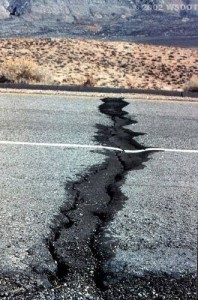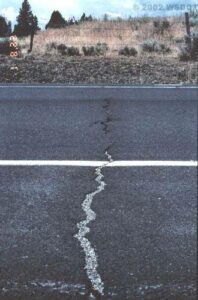Transverse (Thermal) Cracking
Transverse cracks are cracks perpendicular to the pavement’s centerline or laydown direction and are usually a type of thermal cracking caused by temperature fluctuations.

A large transverse crack caused by the pavement’s contraction in cold weather. The crack has subsequently been patched as a temporary fix.

Another transverse crack caused by thermal contraction during cold weather. This crack has been sealed.
Problem
These cracks allow moisture infiltration and cause pavement roughness.
Possible Causes
- Shrinkage of the HMA surface due to low temperatures or asphalt binder hardening
- Reflective crack caused by cracks beneath the surface HMA layer
- Top-down cracking
Repair
Strategies depend upon the severity and extent of the cracking, but transverse cracks are typically full pavement depth, so to completely get rid of them, the pavement structure would need to be reconstructed. If you are looking to save the pavement structure without reconstruction, the best bet is to seal the cracks to prevent moisture intrusion ito the subgrade and to prevent further deterioration of the crack. HMA can provide years of satisfactory service after developing small cracks if they are kept sealed (Roberts et. al., 1996).
- Low severity cracks (< 1/2 inch wide and infrequent cracks). Crack sealing can be done with a rubberized crack seal material and will typically perform very well for many years.
- High severity cracks (> 1/2 inch wide and numerous cracks). Crack sealing is typically done with a mastic material.
Surface Distresses



